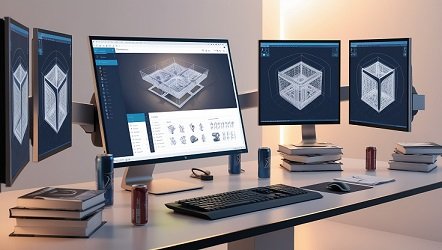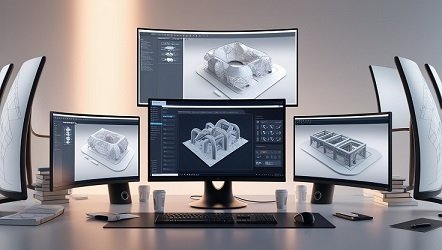Imagine a world where your wildest design dreams come to life with just a few clicks. 🖱️ From breathtaking architectural marvels to intricate product prototypes, the realm of 3D modeling software has unlocked a universe of possibilities for designers, engineers, and creatives across the globe. But with so many options flooding the market, how do you navigate this digital landscape to find the perfect tool for your vision?
Enter the revolutionary world of cutting-edge 3D modeling software. These powerful tools are not just changing the game; they’re redefining it entirely. Whether you’re a seasoned professional or an aspiring novice, the right this software can transform your ideas from mere concepts to stunning, tangible realities. In this blog post, we’ll dive deep into the best 3D modeling software that’s reshaping the design world, exploring their game-changing features, and uncovering how they’re revolutionizing industries from entertainment to manufacturing and beyond.

Top 3D Modeling Software Revolutionizing Design
AutoCAD: Precision in Engineering and Architecture
AutoCAD remains a powerhouse in the realm of computer-aided design, offering unparalleled precision for engineers and architects. Its robust feature set includes:
- 2D and 3D drafting capabilities
- Parametric drawing tools
- Customizable user interface
Blender: Open-Source Power for 3D Artists
Blender has emerged as a formidable open-source alternative, beloved by 3D artists worldwide. Key strengths include:
- Comprehensive 3D creation suite
- Powerful modeling and sculpting tools
- Advanced animation capabilities
SketchUp: Intuitive Design for Beginners and Professionals
SketchUp stands out for its user-friendly interface and quick learning curve, making it ideal for both novices and experts. Notable features:
- Easy-to-use 3D modeling tools
- Extensive library of pre-made 3D models
- Web-based and desktop versions available
Maya: Industry Standard for Animation and Visual Effects
Autodesk Maya is the go-to software for high-end 3D animation and visual effects. Its capabilities include:
- Advanced character rigging and animation
- Realistic physics simulations
- High-quality rendering options
| Software | Best For | Key Strength |
|---|---|---|
| AutoCAD | Engineering & Architecture | Precision |
| Blender | 3D Artists | Versatility |
| SketchUp | Beginners & Professionals | Ease of Use |
| Maya | Animation & VFX | Industry Standard |
These powerful tools are reshaping the design landscape, offering professionals and enthusiasts alike the ability to bring their creative visions to life with unprecedented detail and realism. As we delve deeper, we’ll explore the key features driving innovation in software.

Key Features Driving 3D Software Innovation
The landscape of 3D modeling software is constantly evolving, with several key features at the forefront of innovation. These advancements are revolutionizing the way designers, architects, and engineers approach their work.
Real-Time Rendering Capabilities
Real-time rendering has become a game-changer in 3D modeling. This feature allows designers to see changes instantaneously, significantly speeding up the iterative process.
| Benefit | Impact |
|---|---|
| Faster workflows | Reduces project timelines |
| Immediate feedback | Enhances creative decision-making |
| Client presentations | Improves communication of ideas |
Cloud-Based Collaboration Tools
Cloud-based collaboration has transformed team dynamics in 3D modeling projects. These tools enable:
- Simultaneous editing by multiple team members
- Version control and change tracking
- Access to projects from any location
VR and AR Integration
Virtual and Augmented Reality integration brings 3D models to life, offering immersive experiences for both designers and clients. This technology allows for:
- Virtual walkthroughs of architectural designs
- Interactive product prototyping
- Enhanced spatial understanding of models
Parametric Modeling Advancements
Parametric modeling has revolutionized the way designers approach complex geometries and iterative design. This feature allows for:
- Dynamic adjustment of model parameters
- Automatic updates across related elements
- Exploration of multiple design variations quickly
AI-Assisted Design Functions
Artificial Intelligence is increasingly being integrated into 3D modeling software, offering:
- Automated optimization of designs
- Intelligent suggestions for improvements
- Streamlined workflows through predictive modeling
These key features are not only enhancing the capabilities of modeling 3D Software but are also opening up new possibilities for creativity and efficiency in design processes. As we explore further, we’ll see how these innovations are being applied across various industries.

Industries Transformed by 3D Modeling Software
Now that we’ve explored the key features driving 3D software innovation, let’s examine how various industries are being revolutionized by these powerful tools.
A. Architecture and Interior Design
3D modeling software has dramatically changed the way architects and interior designers conceptualize and present their ideas. These tools enable:
- Realistic visualization of buildings and spaces
- Virtual walkthroughs for clients
- Improved collaboration among team members
B. Product Development and Manufacturing
In the world of product design and manufacturing, 3D modeling software has become indispensable. Benefits include:
- Rapid prototyping and iteration
- Reduced production costs
- Enhanced quality control
C. Film and Game Production
The entertainment industry has been transformed by 3D modeling software, allowing for:
- Creation of lifelike characters and environments
- Seamless integration of CGI with live-action footage
- Development of immersive virtual worlds
D. Medical Imaging and Research
3D modeling software has revolutionized medical imaging and research, offering:
- Advanced visualization of anatomical structures
- Surgical planning and simulation
- Custom prosthetic design
| Industry | Key Benefits of 3D Modeling Software |
|---|---|
| Architecture | Realistic visualizations, virtual walkthroughs |
| Manufacturing | Rapid prototyping, cost reduction |
| Entertainment | Lifelike characters, immersive worlds |
| Medicine | Advanced imaging, surgical planning |
As we can see, 3D modeling software has had a profound impact across various sectors, enhancing creativity, efficiency, and innovation.
Choosing the Right 3D Modeling Software
Now that we’ve explored the various industries transformed by 3D modeling software, let’s focus on how to select the perfect tool for your needs.
A. Assessing Your Skill Level and Project Requirements
When choosing 3D modeling software, it’s crucial to consider your expertise and project goals. Here’s a quick guide:
| Skill Level | Recommended Software Types | Project Complexity |
|---|---|---|
| Beginner | User-friendly, intuitive | Simple models, basic animations |
| Intermediate | Versatile, feature-rich | Detailed models, basic simulations |
| Advanced | Specialized, powerful | Complex simulations, photorealistic renders |
B. Comparing Pricing Models and Licensing Options
3D modeling software comes with various pricing structures:
- Subscription-based (monthly/yearly)
- Perpetual license (one-time purchase)
- Free and open-source options
Consider your budget and long-term needs when evaluating these options.
C. Evaluating Hardware Compatibility and Performance
Ensure your hardware can handle the software’s requirements:
- CPU processing power
- GPU capabilities
- RAM capacity
- Storage space
D. Considering Learning Resources and Community Support
The availability of learning materials and a supportive community can significantly impact your experience:
- Official documentation and tutorials
- Third-party courses and workshops
- Active user forums and community groups
- Regular software updates and improvements
By carefully considering these factors, you’ll be better equipped to choose the 3D modeling software that best suits your needs and helps you bring your creative visions to life. Read more what is business process management software for SMEs?
Future Trends in 3D Modeling Software
As 3D modeling software continues to evolve, several exciting trends are shaping the future of design. Let’s explore these innovations that are set to transform the industry.
Increased Photorealism and Physics Simulation
The pursuit of ultra-realistic renderings is driving advancements in photorealism. Simultaneously, improved physics simulations are enhancing the accuracy of virtual prototypes.
| Feature | Benefits |
|---|---|
| Ray tracing | Lifelike lighting and reflections |
| Advanced materials | Accurate representation of textures |
| Real-time physics | Immediate feedback on design changes |
Integration with 3D Printing Technologies
Seamless integration between 3D modeling software and 3D printers is becoming increasingly important. This trend facilitates:
- Direct export of print-ready files
- Automatic optimization for different printing materials
- Real-time cost estimation for 3D printing projects
Enhanced Mobile and Tablet Capabilities
The demand for on-the-go design solutions is fueling the development of powerful mobile 3D modeling apps. These applications offer:
- Touch-based modeling interfaces
- Cloud synchronization for cross-device workflow
- AR-enhanced design visualization
Expansion of AI-Driven Design Tools
Artificial intelligence is revolutionizing 3D modeling by introducing:
- Automated topology optimization
- Generative design algorithms
- Intelligent error detection and correction
Cross-Platform Compatibility and Seamless Workflow
The future of 3D modeling software lies in creating ecosystems that support seamless workflows across different platforms and devices. This trend focuses on:
- Universal file formats for easy sharing
- Cloud-based collaboration tools
- Integration with other design and engineering software
As these trends continue to shape the 3D modeling landscape, designers and engineers can look forward to more powerful, efficient, and accessible tools that will push the boundaries of creativity and innovation.
Conclusion
The world of 3D modeling software continues to evolve at a rapid pace, offering designers and industries unprecedented capabilities to bring their visions to life. From top-tier software solutions to innovative features and industry-specific applications, 3D modeling tools are reshaping the design landscape across various sectors. As we’ve explored, choosing the right software depends on your specific needs, project requirements, and skill level.
As we look to the future, the realm of 3D modeling software promises even more exciting developments. With advancements in artificial intelligence, virtual reality integration, and cloud-based collaboration, the potential for creating and manipulating 3D models will only continue to expand. Whether you’re a professional designer, an industry specialist, or an enthusiast, embracing these powerful tools can unlock new possibilities and transform your creative process. Stay informed, experiment with different software options.
